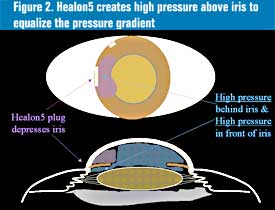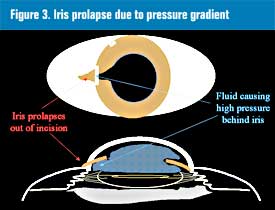Management of iris prolapse in cataract surgery
The technique of equalizing pressure gradients.
![Back to Basics [logo] Back to Basics [logo]](/images/commonart/b2basicssm.jpg)
During cataract surgery, the iris can prolapse out of the incision, causing difficulty with the surgery and damage to the delicate iris.
There are factors that make the iris more likely to prolapse out of the incision: a lack of tone as seen in floppy iris syndrome, an inadequately dilated pupil, a poorly constructed clear corneal incision and a shallow anterior chamber. However, the reason behind the iris prolapse is always a pressure gradient.
Pressure gradients cause iris prolapse
With a pressure gradient, the iris will move from the area of high pressure to the area of low pressure. Equalizing the pressure gradient is instrumental in solving the problem of intraoperative iris prolapse.
We know from our experiences treating ruptured globes that the iris is a mobile and kinetic structure that can plug up a globe perforation. A peaked pupil is a cardinal sign of a ruptured globe with the peak corresponding to the area where the iris has moved from the area of high pressure (intraocular) to low pressure (the environment outside the eye) to seal the perforation and prevent further collapse of the eye.
![Uday Devgan, MD, FACS [photo] Uday Devgan, MD, FACS [photo]](/~/media/images/shared-images/devgan_70_90_12402.jpg) Uday Devgan |
In cataract surgery, prolapse of the iris during phacoemulsification or cortex removal is due to the creation of a high-pressure state within the eye. The infusion pressure from the hanging bottle of balanced salt solution can routinely create intraocular pressures in excess of 50 mm Hg. When this inflow of fluid is directed under the iris, prolapse can occur. Other sources of pressure posterior to the iris can worsen this pressure gradient, such as orbital pressure from a tight speculum or an excessive retrobulbar anesthetic block, posterior segment pressure from a choroidal hemorrhage or anterior segment fluid misdirection or saline trapped behind the cataract.
Any time the pressure behind the iris is greater than the pressure in front of it, the iris will tend to prolapse out of the incision. The treatment is always the same: equalize the pressure gradient. This can be done by either raising the pressure above the iris or lowering the pressure behind the iris. Once the pressure gradient has been neutralized, the iris will return to its natural position.
Equalizing the pressure gradient by raising the pressure
When the iris prolapses out of the incision during phacoemulsification or cortex removal, the best treatment is to raise the pressure in front of the iris (Figure 1). Because there is already a high-pressure state behind the iris due to the infusion pressure from our phaco machine, we need to balance this pressure by increasing the pressure in front of the iris. This can be done by re-directing the fluid inflow so that the inflow of fluid is above the iris. However, this is not always easy because our instruments are constantly moving within the anterior segment.
In these cases, I prefer the use of a viscoadaptive device such as Healon 5 (sodium hyaluronate, Advanced Medical Optics) in order to create a plug of viscoelastic above the sub-incisional iris (Figure 2). This plug of the viscoadaptive device creates a constant high-pressure state above the sub-incisional iris during cataract removal. Because Healon 5 behaves differently from traditional cohesive or dispersive viscoelastics, I prefer to just use a single plug of Healon 5 with the rest of the eye filled with my traditional dispersive viscoelastic.
|
|
|
|
|
Images: Devgan U |
Equalizing the pressure gradient by lowering the pressure
When the iris prolapses out of the incision toward the end of the case, the best treatment is to lower the pressure behind the iris (Figure 3). We do not want to leave viscoelastic in the eye at the end of our cataract surgery, so adding more viscoelastic at this point would not be ideal. With the IOL implant already in the capsular bag, there is no need for the high pressures associated with the phaco machine infusion.
Simply depressing the iris and IOL and flattening the anterior chamber will immediately neutralize the pressure gradient and the iris will return to its normal position (Figure 4). The corneal incisions can then be sealed, and the eye can be re-inflated via the paracentesis. During re-inflation, if care is taken to direct the fluid on top of the iris and not below it, the iris will remain in its normal position and will not prolapse again.
Summary
Iris prolapse is always due to a pressure gradient, with high pressure behind the iris and low pressure in front of it. Solving the dilemma of iris prolapse always means neutralizing the pressure gradient, either by raising the pressure in front of the iris, or lowering the pressure behind it.
During cataract removal with the phaco machine infusion causing high pressure behind the iris, the treatment is using a viscoadaptive device to create a plug of viscoelastic, which causes a high pressure in front of the iris. The pressure gradient will then be neutralized, and the iris will no longer prolapse.
At the end of our routine cases, if there is iris prolapse, it is due to high pressure behind the iris. In this situation, temporarily flattening the anterior chamber and releasing the fluid from behind the iris will lower the pressure behind the iris. With equally low pressures in front and behind the iris, the pressure gradient has been neutralized and the iris will return to its normal position.
For more information:
- Uday Devgan, MD, FACS, is in private practice at Devgan Eye Surgery in Los Angeles, Beverly Hills, and Newport Beach, California. Dr. Devgan is Chief of Ophthalmology at Olive View UCLA Medical Center and an Associate Clinical Professor at the Jules Stein Eye Institute at the UCLA School of Medicine. Dr. Devgan can be reached at 11600 Wilshire Blvd., Suite 200, Los Angeles, CA 90025; 800-337-1969; fax: 310-388-3028; e-mail: devgan@gmail.com; Web site: www.DevganEye.com. Dr.Devgan is a consultant to Abbott Medical Optics and Bausch & Lomb, and is a stockholder in Alcon Laboratories and formerly in Advanced Medical Optics.




